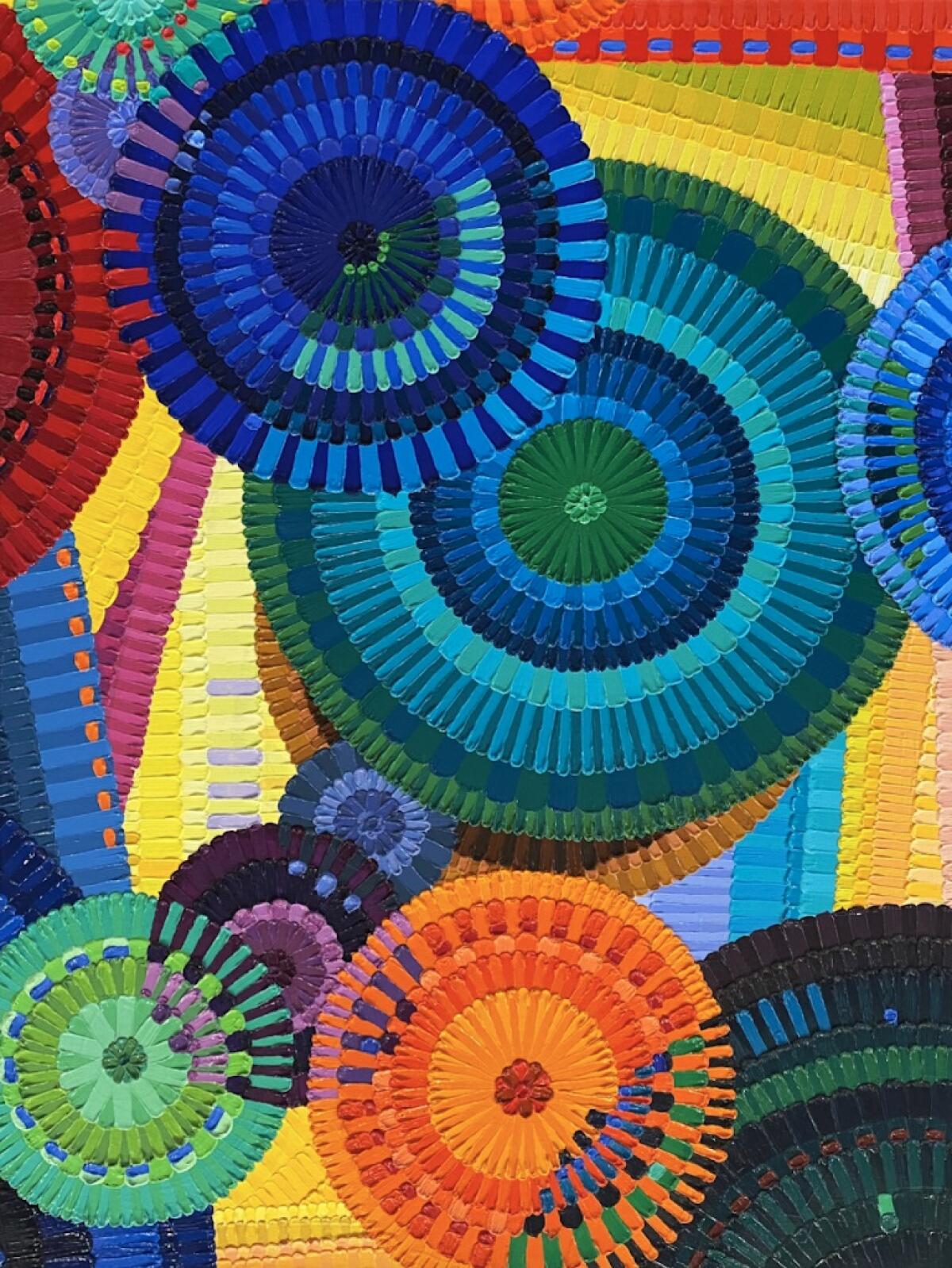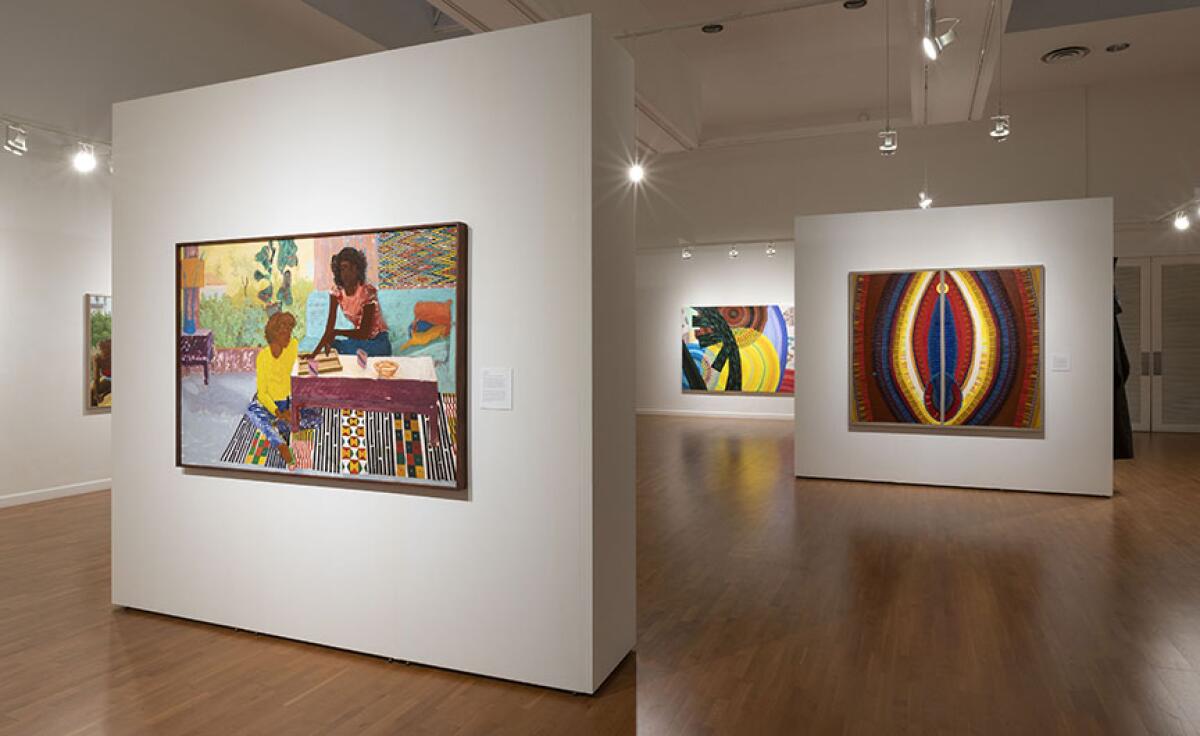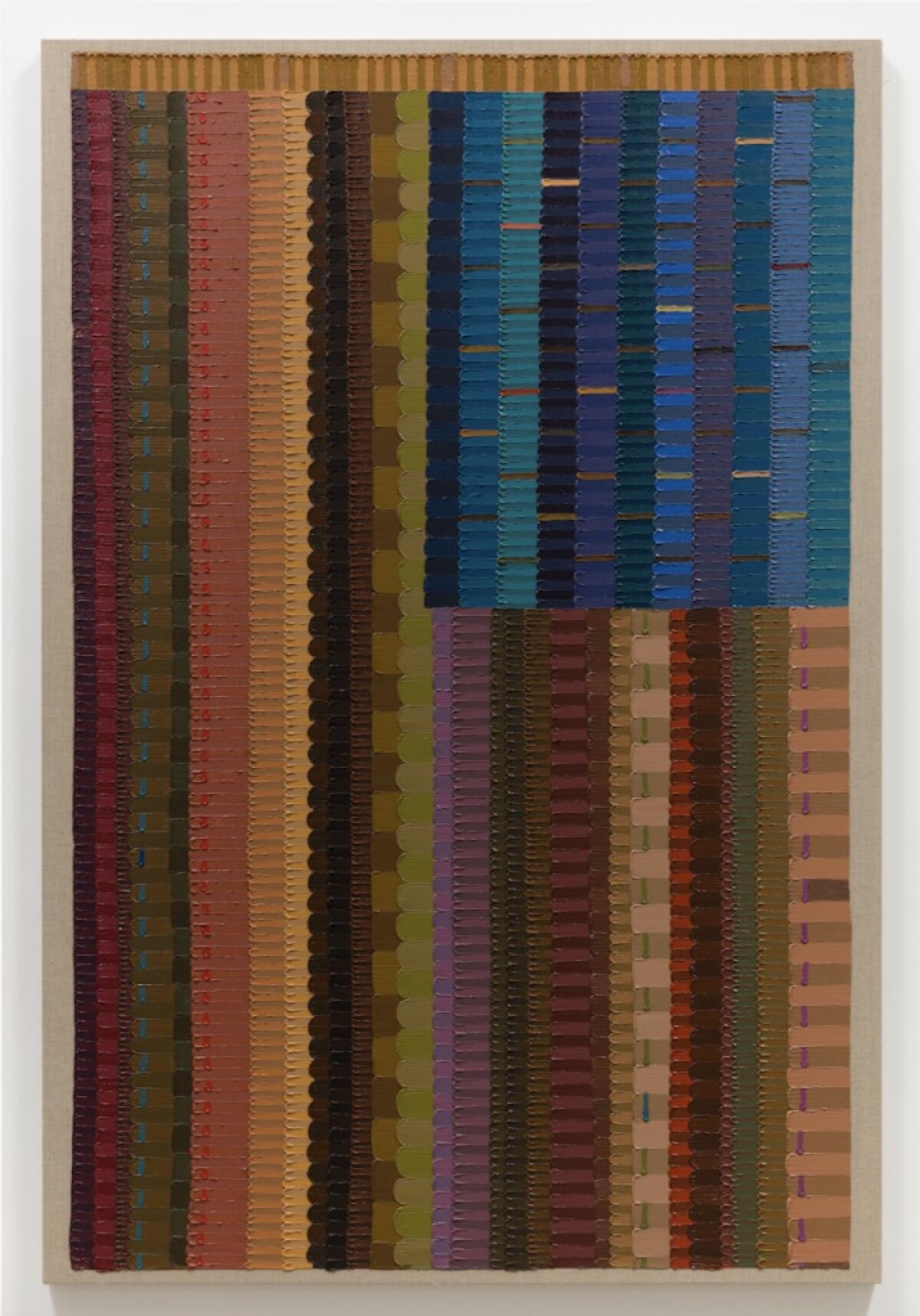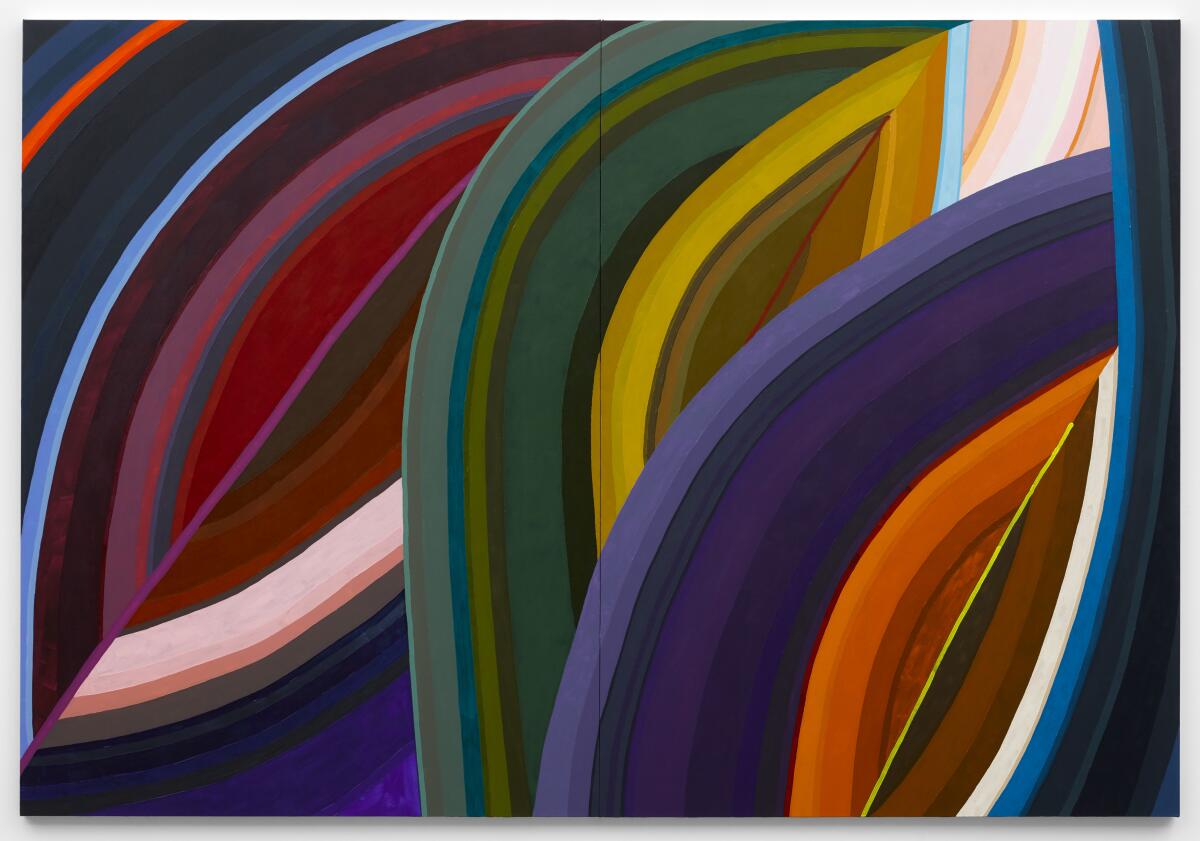Review: A welcome June Edmonds survey illuminates the artist’s surprising trajectory

Nine years ago, June Edmonds made a painting that, if not an immediate turning point in the 40-year development of her work, nonetheless signaled a direction that has lately come into full flower.
“Gee’s Jungle” (2012) is included in the aptly titled survey “June Edmonds: Full Spectrum,” at Loyola Marymount University’s Laband Art Gallery in Westchester. The painting is composed of about a dozen mandala-like geometric disks of saturated color — the full spectrum — rendered in short, thick strokes of dense paint, each laid on with controlled concentration.
The L.A.-based artist mixed pure pigment with gel. Each short stroke, one after the next, ends in an even thicker ridge of piled-up paint. Surface texture catches the light. Shapes ride flat on the painting’s surface, but a shallow optical space opens up.
The color plane dazzles. Look closely, and at every place where one disk intersects with another, the palette changes.
Sky-blue marks shift into a sapphire segment, for example, or different shades of orange suddenly alternate with emerald green. It’s as if the color in one disk is pulling in hues from the overlapping disk, before changing again where it overlaps onto another one.
The individual integrity of the marks and shapes remains intact, all while becoming woven into the larger whole. The ritual repetition of strokes yields a meditative quality, which the vivid color transforms into joy.
The title, “Gee’s Jungle,” suggests an inspiration: It refers to the great quilts of Gee’s Bend, the small town at a turn in the Alabama River where a rural community of Black women has gained an international reputation for producing textile works of astonishing beauty.

It might also recall a legacy from West Africa, home to myriad brilliant textile traditions. Edmonds’ title weaves and layers those associations the way her painted disks weave and layer color.
The welcome Laband survey, organized by gallery director Karen Rapp, begins with student work from the 1980s, when Edmonds, now 62, was enrolled as an undergrad at San Diego State University. Twenty paintings are joined with 18 works on paper, plus a few self-portrait pencil studies and assorted ephemera.
Billed as a retrospective, it’s more like a thumbnail sketch for one, given the modest size. But the often-bracing selection does give a good sense of the artist’s development over four decades.
Early representational paintings depict the artist at work in her studio, young women playing a board game on the living room coffee table or friends hanging out in her kitchen. The flat, simplified forms of David Hockney come to mind, while a few still lifes display an interest in Henri Matisse, with plants on tabletops merging into organic wallpaper patterns.
One still life features bird-of-paradise blossoms, plus bananas and oranges piled on a table, rendered almost in silhouette. Brightly colored chevrons in the tablecloth are a virtual fusion of a Jasper Johns’ crosshatch painting with the poured color of Morris Louis’ stripes. The tablecloth demonstrates an abstract taste for color and pattern in figurative guise.
An awkwardness to Edmonds’ early paint-handling sometimes interferes with her evolving deftness in composing space. Most interesting is the insertion of lively hanging textiles, patterned carpets and clothing into the scenes of everyday life — abstract imagery that eventually moves into the foreground, leaving most figurative representation behind.

Edmonds’ trajectory, to oversimplify a bit, has played against existing expectations. Given the current success of such stylistically and conceptually diverse painters as Lynette Yiadom-Boakye, Henry Taylor, Kehinde Wiley and especially Kerry James Marshall, figurative work that puts images of Black life into a larger artistic legacy where relatively few are established is what’s commonly encountered now.
For Edmonds, the early figurative work feels determined but conventional, while the more recent abstract paintings take off like a rocket. In a recent online lecture for the Museum of Contemporary Art San Diego and UC San Diego, she noted a recurrent tension within Black art since the Harlem Renaissance of the 1920s and 1930s: the clear need for Black representations of Black life in a white-dominated society presses against the freedom to explore other artistic avenues.
Edmonds made a dozen Venetian glass mosaics for a 1995 public art commission at the Metro Pacific Station in Long Beach. These are scenes of diverse neighborhood people built from a medium that assembles fragments of color to form a picture. But, in “Gee’s Jungle,” the more obvious artistic influence — in addition to those astounding quilts — is the work of Washington Color School painter Alma Thomas (1891-1978).
Before you realize that June Edmonds’ abstract paintings echo the structure of the star-spangled banner, your gut tells you that you have entered a place of mourning, where a tragic loss is being grieved.
Thomas’ luminous, abstract atmospheres of pure color were assembled from short marks of paint arrayed in veils, mandalas, vertical cascades and organic dispersals, sometimes recalling exuberant flower beds. They’re the syntax for Edmonds’ denser, more structured compositions.
At Laband, a group of flat, six-foot-tall American flag paintings splits the difference between abstraction and representation. The field for the stars and stripes is rendered in short, firm strokes of rich color, painted marks whose definite horizontality plays against the upright verticality of the image. Edmonds isn’t flag-waving; instead, she’s visually weaving the warp and weft of a painted textile for contemplation.
One flag is composed solely from purples, browns, deep greens and shades of black, rendered almost like strands of genetic code. Everywhere the flags emphasize brown as integral to the national banner, radiating a somber gravity. They foster a ravishing meditation appropriate to the subject — and to demands of our current national mood.

An invigorating group of new abstractions — the largest paintings of her career, some more than seven feet high and 10 feet wide — were shown recently at Luis De Jesus gallery in downtown Los Angeles. They suggest an expansive confidence that the retrospective supports.
Their big, bold, banded lozenges of color establish two-dimensional portals to sweeping, optically deep space beyond the canvas surface. The lozenge, a shape recalling a vulva, adds an element of feminine sexuality to a thrilling sense of transport and emerging spiritual power.
June Edmonds: Full Spectrum
Laband Art Gallery, Loyola Marymount University, 1 Loyola Marymount University Dr., (310) 338-2880, through Dec. 11. Public hours on Saturday and Sunday, reservation required. cfa.lmu.edu/labandgallery
More to Read
The biggest entertainment stories
Get our big stories about Hollywood, film, television, music, arts, culture and more right in your inbox as soon as they publish.
You may occasionally receive promotional content from the Los Angeles Times.











